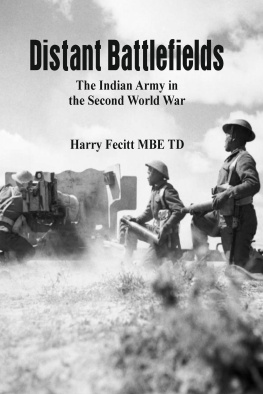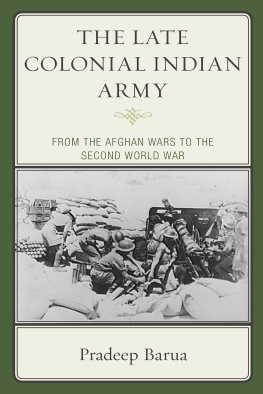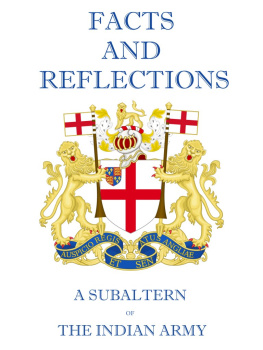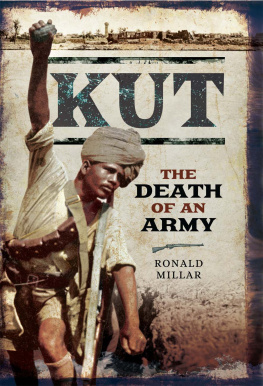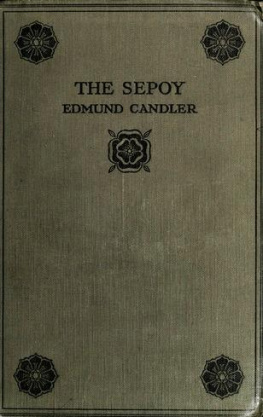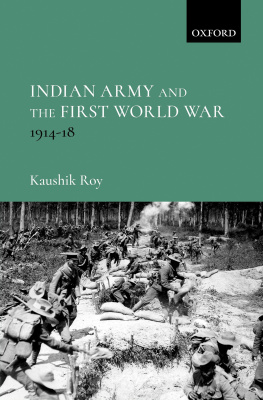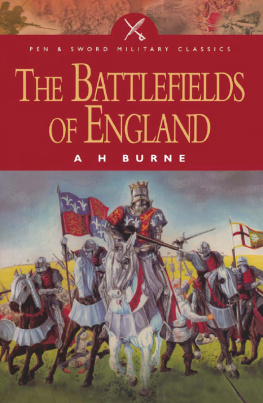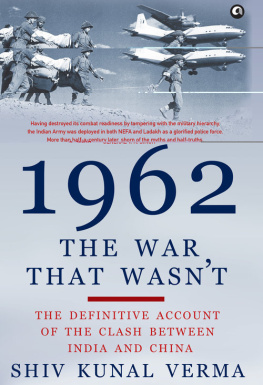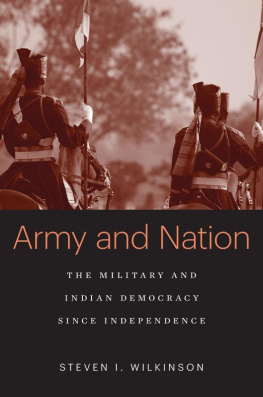Harry Fecitt - Distant Battlefields: The Indian Army in the Second World War
Here you can read online Harry Fecitt - Distant Battlefields: The Indian Army in the Second World War full text of the book (entire story) in english for free. Download pdf and epub, get meaning, cover and reviews about this ebook. year: 2019, publisher: Book Network Intl Limited trading as NBN International (NBNi), genre: Non-fiction. Description of the work, (preface) as well as reviews are available. Best literature library LitArk.com created for fans of good reading and offers a wide selection of genres:
Romance novel
Science fiction
Adventure
Detective
Science
History
Home and family
Prose
Art
Politics
Computer
Non-fiction
Religion
Business
Children
Humor
Choose a favorite category and find really read worthwhile books. Enjoy immersion in the world of imagination, feel the emotions of the characters or learn something new for yourself, make an fascinating discovery.
- Book:Distant Battlefields: The Indian Army in the Second World War
- Author:
- Publisher:Book Network Intl Limited trading as NBN International (NBNi)
- Genre:
- Year:2019
- Rating:5 / 5
- Favourites:Add to favourites
- Your mark:
- 100
- 1
- 2
- 3
- 4
- 5
Distant Battlefields: The Indian Army in the Second World War: summary, description and annotation
We offer to read an annotation, description, summary or preface (depends on what the author of the book "Distant Battlefields: The Indian Army in the Second World War" wrote himself). If you haven't found the necessary information about the book — write in the comments, we will try to find it.
Harry Fecitt: author's other books
Who wrote Distant Battlefields: The Indian Army in the Second World War? Find out the surname, the name of the author of the book and a list of all author's works by series.
Distant Battlefields: The Indian Army in the Second World War — read online for free the complete book (whole text) full work
Below is the text of the book, divided by pages. System saving the place of the last page read, allows you to conveniently read the book "Distant Battlefields: The Indian Army in the Second World War" online for free, without having to search again every time where you left off. Put a bookmark, and you can go to the page where you finished reading at any time.
Font size:
Interval:
Bookmark:
Distant Battlefields
Distant Battlefields
The Indian Army in the
Second World War
Harry Fecitt MBE TD

Centre for Armed Forces Historical Research
United Service Institution of India
New Delhi

Vij Books India Pvt Ltd
New Delhi (India)
Published by
Vij Books India Pvt Ltd
(Publishers, Distributors & Importers)
2/19, Ansari Road
Delhi 110 002
Phones: 91-11-43596460, 91-11-47340674
Fax: 91-11-47340674
e-mail:
Copyright 2019, United Service Institution of India, New Delhi
ISBN: 978-93-88161-76-3 (Hardback)
ISBN: 978-93-88161-78-7 (ebook)
All rights reserved.
No part of this book may be reproduced, stored in a retrieval system, transmitted or utilised in any form or by any means, electronic, mechanical, photocopying, recording or otherwise, without the prior permission of the copyright owner. Application for such permission should be addressed to the publisher.
It gives me great pleasure to write this foreword to Harry Fecitts latest contribution to the history of the Indian Army. The Second World War was a corollary to the First and the chain of events that were set in motion following the end of the First Great War saw their culmination in the aftermath of the Second. In South Asia, the war brought about the end of empire and a new chapter in Indian history with the declaration of independence in August 1947. It also brought about the tragic partition of the subcontinent into India and Pakistan with its attendant human cost and an acrimony that continues to bedevil political relations between the two nations to this day.
However, this book is not about politics. It is a soldiers tribute to a legion that has passed into history the undivided Indian Army. During the period 1939-1945 the Indian Army expanded from its pre-war strength of little over 2,00,000 all ranks in September 1939 to approximately 9,00,000 by 1941 and over two and a half million by 1945. It was the largest all-volunteer army in the history of human conflict. Indian Divisions saw action in nearly every theatre of the war, from France and Italy in Europe, to East Africa, Eritrea, Sudan and Somaliland, to North Africa and the western desert; Egypt and the Persia-Iraq Force; Burma, Malaya, Singapore, Hong Kong and South East Asia. By the end of the war, the 4th and 5th, Indian Divisions were household names and were counted amongst the best fighting formations in the world. Soldiers of the Indian Army comprised more than two-thirds of the Allied land Forces in South East Asia. As the commander of the indomitable 14th Army, Field Marshal Sir William Slim, famously remarked in his book Defeat into Victory, My Indian Divisions after 1943 were among the best in the world. They go anywhere, do anything, go on doing it, and do it on very little.
The credit for moulding the Indian Army into the formidable fighting force that rose like the phoenix to convert defeat into victory on the Burma front goes to Slims ability to learn from the lessons of the past and to instil his officers and troops with a new sense of purpose and a confidence born of thorough training and proper equipment.
The Second World War provided the anvil upon which the blade of the Indian Armed Forces was forged and which has stood the nation in good stead ever since. The experience gained during the war also laid the foundations of a professional army that was capable of fighting in varied terrain and against different though equally resolute adversaries. Most importantly, the Indian Army saw its middle rung officers perform commendably during the war, winning awards and accolades for their bravery and leadership,
The 30 Victoria Crosses that its soldiers won during the war stood testimony to the valour of the Indian Army. While the tales of bravery of the VC recipients are well known, the author has gone to great pains to dig out old records to highlight the deeds of valour and extraordinary devotion to duty of the numerous ordinary soldiers who figure in his accounts. It is this emphasis on naming the un-named, and emphasising the service of the unsung that sets this book apart from many others of its ilk.
The chapters of this book are testimony to the extraordinary services rendered by the undivided Indian Army during the Second World War. They cover the vast geographical expanse over which Indian soldiers fought and died and take the reader from the beaches of Dunkirk to the sands of the Sahara and the steaming jungles of Malaya and Burma to the Italian mountains where Indian soldiers served in some of the most epic battles of the twentieth century.
This book will form a most useful addition to every military library in South Asia. The author deserves the collective thanks of all who take an interest in the military history of the subcontinent for his dedicated efforts to highlight the part played by its soldiers in the global struggle against fascism and tyranny during the Second World War.

Rana TS Chhina
INITIAL ENCOUNTERS FIGHTING THE ITALIANS IN
THE SUDAN, 1940
East Africa in 1940
When Italy declared war on Britain and France on 10th June 1940 a serious threat confronted British Somaliland, Kenya and the Sudan, as the Italians had built up large forces in Eritrea, Abyssinia and Italian Somaliland. A strong air force of over 200 aeroplanes in Italian East Africa supported an estimated 30,000 European and 100,000 locally enlisted colonial troops who possessed 400 artillery guns, 200 light tanks and 20,000 lorries. In comparison, British forces were very weak and generally had been trained and equipped for Internal Security duties.
British Somaliland was successfully invaded by Italy in August 1940, the British defenders fighting a withdrawing action before evacuating themselves to Aden. Italian units crossed into the Northern Frontier District of Kenya, occupying British border posts at Moyale and El Wak, and sending irregular troops to raid further into the District; the three battalions of the Kings African Rifles in the District could only watch, harass and withdraw as the enemy advanced.
In the Sudan, as in Kenya, the three British Army battalions there and the units of the Sudan Defence Force a total of 9,000 men could only offer a mobile defence against enemy intrusions, and by the end of July Italian troops were in possession of British frontier posts at Karora, Kassala, Gallabat and Kurmuk. However, having crossed the British frontiers the Italians did not take advantage of British weaknesses and they remained static instead of exploiting military opportunities further inside British territory. This pause in enemy activity allowed British reinforcements to arrive. Indian troops were landed in the Sudan whilst West and South African troops moved into Kenya. In Sudan this reinforcement allowed aggressive British action to be mounted but initial military encounters with the Italians were not as successful as had been anticipated, and some hard military lessons were learned.
British Forces in the Sudan
On the outbreak of hostilities with Italy the British military commander in Sudan, Major-General W. Platt CB, DSO, had under command the British Army 21st Brigade, an administrative rather than a tactical formation, which consisted of three pre-war Regular Army battalions: the 2nd Battalion The West Yorkshire Regiment (Prince of Wales Own), the 1st Battalion The Worcestershire Regiment, and the 1st Battalion The Essex Regiment. He also commanded the locally-enlisted Sudan Defence Force (SDF) whose units were battalion-sized but named as Corps: the Camel Corps, the Eastern Arab Corps, the Western Arab Corps and the Equatorial Corps. These Corps were organized into a total of 20 Companies, six of them being Motor Machine Gun (MMG) Companies that were small mobile units whose main weapon was the light machine gun. A unit titled the Sudan Horse was in the process of being converted into a 3.7-inch howitzer battery.
Next pageFont size:
Interval:
Bookmark:
Similar books «Distant Battlefields: The Indian Army in the Second World War»
Look at similar books to Distant Battlefields: The Indian Army in the Second World War. We have selected literature similar in name and meaning in the hope of providing readers with more options to find new, interesting, not yet read works.
Discussion, reviews of the book Distant Battlefields: The Indian Army in the Second World War and just readers' own opinions. Leave your comments, write what you think about the work, its meaning or the main characters. Specify what exactly you liked and what you didn't like, and why you think so.

